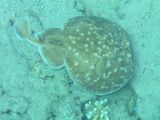The electric organs are specialized organs, derived from the muscles or the nerve cell's axon, that can generate electric current, employed from catching the prey (electro-paralysis) to defense, orientation (electro-location, similar the way bats and dolphins use ultrasounds in ecolocation), or as a means of communication, for mating, feeding or territory defense. The electric fish, producing electricity, are electrogenic, but as they sense the electricity they are also electroreceptive.
There are species that are not electrogenic, being only electroreceptive, detecting the weak fields generated by their prey (any living thing generates a weak electric field, which could be just 0.01 microvolts), like sharks, rays (except the electric ones, which are also electrogenic), lungfishes and even ... the platypus (a mammal!). It clearly appears that electricity works only in water.
There are about 500 species of electric fish. Here are the most important examples:
1. Electric eel (Electrophorus electricus) is the most infamous electric fish. It can grow up to 2.5 m (8.2 ft) in length and 20 kg (44 pounds) in weight. It inhabits the Amazon and Orinoco basins, in South America. This fish has 3 pairs of abdominal electric organs occupying 4/5 of its body. They have 62 columns with 2,000-6,000 electroplates.
It generates two types of electric organ discharges (EODs) from different electric organs: a low-voltage EODs (about 10 V) from the Sach's organ at rates of up to 25 Hz, and a high-voltage EODs (about 500 V) emitted by the main and Hunter's organs at highest rates of up to several hundred Hz. Low-voltage EOD are used for electro location whereas high-voltage EOD are used for attack or defense.
Large individuals can produce a shock of up to 500 volts and 1 ampere of current (500 watts). It is enough to kill a horse, and half of this value is more than enough to kill a human.
This fish is not a real eel, but its relatives are the American knifefises. When agitated, electric eels can produce intermittent strong electrical shocks over a period of at least an hour without signs of tiring. The species can stun or kill their prey just by touching it and they can stun or deter any animal.
2. Electric rays (Torpediniformes, 2 families, 11 genera, 38 species) are real rays, with a round flattened body. They generate electric currents of 8-220 volts (in sea water, the electric current passes more easily) to kill or stun their prey with their head electric organs, derived from bronchial muscles. Some can be as little as 14.5 cm (5 inch) long (and are of course, relatively harmless), but the largest individuals (up to 1.8 m (6 ft) and 90 kg (200 pounds)) can be lethal for humans. The most known and powerful species are those of the genus Torpedo (numbfish), described even by the ancient Greeks. They store electricity in the tissues that act like a battery.
3. Electric catfish (family Malapteruridae) represent a group of African freshwater catfish with the ability to produce a strong electric discharge of up to 350 volts (enough to kill a human) employing electroplates. Their prey is paralyzed with electric shocks. They can grow up to 1.2 m (4 feet) in length and 20 kg (45 pounds) in weight. As they are found in the Nile, the ancient Egyptians knew the electric catfish which are represented in some ancient images. From about 12 known species, most are dwarf of no more than 30 cm (12 inches) in length.
4. Elephantfishes (family Mormyridae, 18 genera, 203 species) live in the African freshwaters and are related to the African knifefish. They generate weak electric fields for electro-location, an adaptation to turbid waters where vision is of no use. Electricity is also used for communication between and within species. Linked to the electricity use, their cerebellum is highly developed. Electric discharges are pulsitile discharges. Many species have modifications of the mouthparts to facilitate feeding upon small invertebrates buried in muddy substrates, hence the name elephant fish. The extensions to the mouthparts (usually made of a fleshy elongation bound to the lower jaw) are flexible, and have touch and taste sensors. The maximum length is of 1 m (3 ft), but most species are under 30 cm (1 ft) long.
5. The African knifefish (Gymnarchus niloticus) lives in African rivers and it is related to the giant arapaima of the Amazon basin, the largest freshwater fish in the world, and the elephantfishes. It has a long and slender body, lacking caudal, ventral, and anal fins. The African knifefish is nocturnal and has poor vision, generating weak electric fields for electro-location. This way it can hunt in darkness. It stuns its prey, but its electric discharges are under 100 volts. It can grow up to 167 cm (65.7 in) and 19 kg (42 lbs). Increased EOD rate by 50-60 Hz occurs between 21 and 31?C. The skin has conductor pores for the electric current. These fish do not swim through ondulatory movements but only with the fins. They change direction using the dorsal fin.
6.The naked-back knifefishes (32 species of the genus Gymnotus species) are found in tropical America, from southern Mexico to northern Argentina, in different types of waters. The largest species can be 0.6 m (2 ft) long. They are related to the electric eel, but they generate only weak electric fields for electro-location, and also for communication during courtship, when males "sing" electric "songs" to the females.
7. The ghost knifefishes (family Apteronotidae) inhabit South American freshwaters. There are 47 species assigned to 13 genera. The longest species can be 1.3 m (4.2 ft). They are nocturnal and have small eyes. The ghost knifefishes use a high frequency tone-type electric organ discharge (EOD) (over 750 Hz at maturity) to communicate.
Most eat aquatic insect larvae, fish and plankton. Magosternarchus spp. has the unique behavior of predating on the Tails of other electric fishes. Sternarchorhynchus and Sternarchorhamphus present tubular snouts and forage on the beds of aquatic insect larvae on the bottom of the river. One species (Sternarchogiton nattereri) feeds on freshwater sponges growing on submerged trees, stumps, and other woody materials.
8. Glass knifefishes, rattail knifefishes (family Sternopygidae, 5 genera, 41 species) live in the South American freshwaters and are related to the electric eel. Most species are highly compressed laterally and translucent. They have large eyes and the largest species can be 140 cm (5 ft) long. Eigenmannia vicentespelea is the only cave-dwelling electric fish. These species have a tone-like EOD), characterized by a monophasic hyperpolarization from negative baseline.
9.Bluntnose knifefishes, grass knifefishes, leaf knifefishes (Hypopomidae family, 7 genera, 35 species) are also related to the electric eel. They inhabit South American freshwaters. They vary in length from 9 to 35 cm (3.6 to 14 inch). They possess extremely small eyes. Their electric organ discharge (EOD) is multiphasic and usually biphasic (the discharges are produced in distinct pulses).
10. Sand knifefishes, tubesnout knifefishes (Rhamphichthyidae family, 3 genera, 15 species) are related to the former and inhabit South American freshwater. They are nocturnal, staying buried in the sand during the day; they use electro-location and vary in length from 0.15 to 1 m (0.5 ft to 3 ft).

 14 DAY TRIAL //
14 DAY TRIAL // 


